The Magic of Alderley Edge
by Liz Hearn
In the villages around Alderley Edge they still tell the old stories of the White Wizard and the white mare. Some believe it is a true story, while others regard it as legend or myth. What is certain is that the escarpment overlooking the Cheshire plain has a magical and mysterious charm, with natural beauty and ancient treasures hidden beneath the surface.
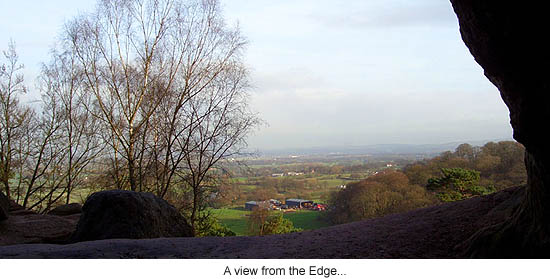
According to the story, a farmer from the local village of Mobberly was passing over the escarpment to sell his white mare at the local market in the neighboring town of Macclesfield. On the way he met a mysterious old man dressed in white who offered to buy the horse. Thinking he would get a better price at market, the farmer refused to sell. The old man predicted that though the horse would be admired at the market, the farmer would not be able to sell it, and promised to wait for the farmer's return. True enough, the horse was admired, but remained unsold while other lesser horses went for a good price. So the farmer returned home with his horse and again on the escarpment met the old man. The offer to buy the horse was repeated and this time the old man struck the nearby rock face with his staff to reveal a secret opening in the rocks with iron gates. The farmer was led inside and there he saw knights of old, dressed for battle, asleep on the ground. By each man except one was a white mare, also asleep. The old man, who the farmer could now clearly see was a wizard, told the farmer that his was the last horse needed for the sleeping army of knights. The knights and horses would sleep on until the country was in its hour of greatest need. Only then would they wake to fight for the nation. The farmer was given gold coins in payment for the mare and led out of the underground place. The iron gates closed and the rocks covered the place, and since that day no-one has found the entrance.
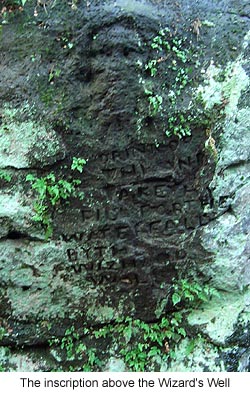 The story has several variations, including Merlin as the white wizard and King Arthur at the head of the army of knights. During World War II locals joked that the hour of need had come, but they hoped the knights would ride not white horses but white tanks. Some suggest it is very similar to old tales told in other parts of Europe. The story was published in Cheshire Gleanings by William E A Axon in 1884. Alderley Edge has also been used by modern writer and mine explorer Alan Garner as the location of his much loved children's mythical fantasy novel The Weirdstone of Brisingamen, which weaves a story around the wizard's myth and Garner's experiences of the mines at Alderley Edge. Alan Garner's great-great-grandfather, a stone-mason, is thought to be perhaps the carver of the wizard's head at the wizard's well -- a spot from which water trickles from the rock face of the escarpment into a stone trough -- along with the inscription, "Drink of this and take thy fill, for the water falls by the Wizard's will."
The story has several variations, including Merlin as the white wizard and King Arthur at the head of the army of knights. During World War II locals joked that the hour of need had come, but they hoped the knights would ride not white horses but white tanks. Some suggest it is very similar to old tales told in other parts of Europe. The story was published in Cheshire Gleanings by William E A Axon in 1884. Alderley Edge has also been used by modern writer and mine explorer Alan Garner as the location of his much loved children's mythical fantasy novel The Weirdstone of Brisingamen, which weaves a story around the wizard's myth and Garner's experiences of the mines at Alderley Edge. Alan Garner's great-great-grandfather, a stone-mason, is thought to be perhaps the carver of the wizard's head at the wizard's well -- a spot from which water trickles from the rock face of the escarpment into a stone trough -- along with the inscription, "Drink of this and take thy fill, for the water falls by the Wizard's will."
Alderley Edge is located on the B5087, just south of the village of the same name in the county of Cheshire. The car park is located down a small track adjacent to the aptly named public house "The Wizard," which is hard to miss on the main road. The views from the escarpment across the Cheshire plain are worth the effort of the short walk through some fine British woodland. The woodland is crossed by a maze of small footpaths to allow you to explore the length of the ridge. In summer its leafy glades and dappled shade offers a refreshing walk. You can explore by yourself or follow one of the color-coded routes show on marked posts starting and ending at the visitor centre. A tea shop is open on weekends and national bank holidays.
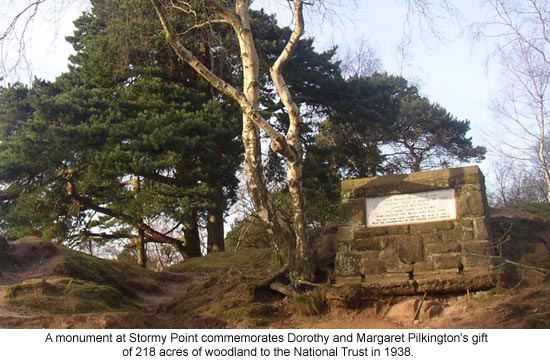
In the 1960s the Edge had a reputation as the meeting place for a witch's coven (which also makes its way into Garner's tale). The coven was broken up, however, and nowadays there are more visitors interested in seeing the sights than in practicing witchcraft. Some come looking for the iron gates, though no one has ever found them. Keep your eyes open for the stone circles found amongst the trees. They are not as old as they might seem, and are thought to have been placed there around 200 years ago as a folly by the Stanley family who then owned the land.
Alderley Edge has a history of attracting those with unusual outlooks on life. John Evans (1883 - 1933) lived as a hermit in the old quarry not far from the car park at Alderley Edge. Though his wooden cabin has long since vanished, you can still find the stone-marked terraces of his garden at the bottom of the quarry and the small tunnel that he used as a larder. Some say he lived there because he did not like women; others say he worked on the Edge, maintaining the paths and planting trees. His death was a mystery; was it murder, or suicide?
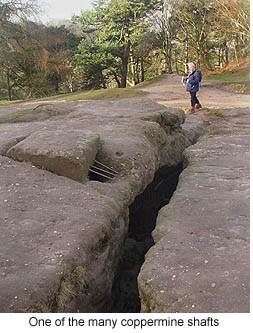 The history of the people of the Edge goes back much earlier, for the rocks forming the edge contain copper ore. The Edge has been mined for thousands of years, starting in the Bronze age and ending in 1926 with the closure of the last commercial mine. The tunnels run for miles under the hillside and are now used by Derbyshire Caving Club. The Club is currently carrying out a program of excavation of some of the older tunnels and has completed work to ensure that these tunnels are not lost through collapse or silting up, or dangerous to visitors walking above.
The history of the people of the Edge goes back much earlier, for the rocks forming the edge contain copper ore. The Edge has been mined for thousands of years, starting in the Bronze age and ending in 1926 with the closure of the last commercial mine. The tunnels run for miles under the hillside and are now used by Derbyshire Caving Club. The Club is currently carrying out a program of excavation of some of the older tunnels and has completed work to ensure that these tunnels are not lost through collapse or silting up, or dangerous to visitors walking above.
Members of the Derbyshire Caving Club open the mines to the general public for two days during April. Attendance is usually high and a time-based ticketing system is used to help as many as possible experience the mines. The Club provides the waterproof all-in-one clothing and helmet and torch equipment you need for the guided tour. Members take their passion for small dark places seriously and during the summer months are able to carry out evening tours of the mines by arrangement. You need to be able to stoop low in some places. The mines are not routinely illuminated except by the headlamp on your helmet. On public open days they are floodlit and a circular route planned for the tour. Visit their website to find out who to contact to arrange a visit. They are highly knowledgeable of the mine and its long history.
The oldest mine workings have revealed a wooden shovel which, when carbon-dated, gave an age of 1750 BC, and stones which are believed to be stone hammers. In the Roman period the hand-worked shafts and tunnel shapes fit with the technology known at the time from other mining sites. The Roman coins and carbon-dating for wood found at the bottom of a shaft give evidence for activity between 75 AD and 320 AD. These were found in Engine Vein, the mine that is most often open to the public on open days.
Even if you don't believe in the myths of Alderley Edge, it is a magical place to experience. The woodland is beautiful and the views on a good day are spectacular. Don't forget to take a picnic and dream of knights on white horses charging to battle on the plains below.
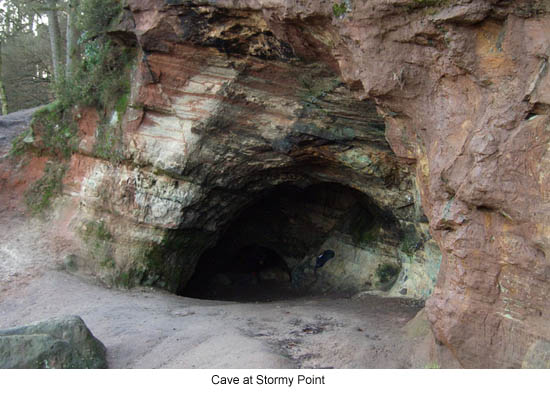
More Information:
We regret that we no longer have the resources to maintain up-to-date links and/or hours and pricing details for the various sites and attractions listed on this website. For more information about the location(s) listed above, please use your favorite search engine or visit Wikipedia.
Liz Hearn is a British freelance writer from the Wirral.
She writes children's articles and travel articles. Her articles
have been published in Transitions Abroad and
Highlights for Children. She lives overseas with her
husband and small daughter and currently lives in Beijing,
China.
Article © 2005 Liz Hearn; photos © John Bews
| 